92 Russian Domain: Urban Geography I – Norilsk (A Resource City)
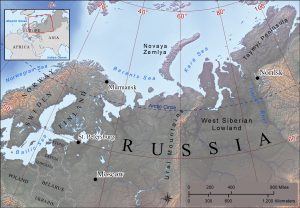
Settled with dual roles as a penal colony in the Soviet gulag and as the ultimate mineral extraction and processing site, Norilsk was an ideal location for both roles. Though some very modest settlement occurred in the 1920s, Norilsk grew rapidly in the late 1930s with an influx of convicts and extraction of mineral deposits. The city now is the world’s northernmost city of at least 100,000 people (177 thousand as of 2012).
The adjacent Taymyr Peninsula had long been known to hold valuable natural resources. A massive and protracted prehistoric eruption of basaltic lava covered the region with minerals, especially in the nickel, copper, and palladium categories.
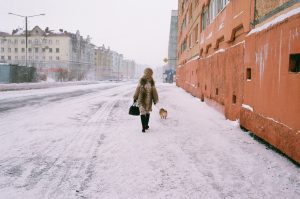
Photo by Евгений Ерыгин on Flickr.
The severe northern location, which at its extreme includes the world’s northernmost continental location, possesses a bitterly cold and harsh climate, essentially nine months of winter, that significantly inhibited settlement of the region. At its worst, the polar winter includes 45 consecutive days when the sun does not rise above the horizon. Not surprisingly even by the early 1930s, the population of the region was dominated by small numbers of native peoples, specifically reindeer herders.
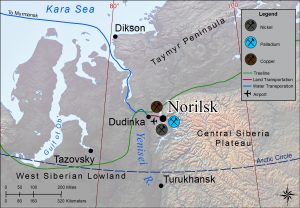
Under Stalin, the 1930s brought a massive surge in the numbers of convicts in the Soviet Union, from political prisoners to petty criminals. Given the historic push for industrial advancement in the USSR, the need for raw materials, including heavy metals, soared. In a sort of perverse logic of supply and demand, the vast supply of prison labor was tapped to fill the demand for the construction of Norilsk and its industry and for the extraction of its minerals. Norilsk’s isolation, hundreds of miles from Moscow, also was ideal for a prison camp. If the prisoners escaped, where would they go? In fact, every other place seems so distant that Norilsk residents often refer to other places in Russia as “the mainland.”
Twelve hundred prisoners arrived in October 1935, but much larger numbers were to follow, such as another 35,000 in 1938. The camp population reached its maximum in 1951 with 72,500 inmates. Given the harsh and sometimes sadistic living conditions in the Soviet gulag and the forbidding climates of prison camps locations, it is ironic that here in Norilsk prisoners received better than average treatment. The vital economic and strategic importance of the development of Norilsk’s resources created a need for great efforts on the parts of the convicts and the need to keep these forced laborers working. Nevertheless, thousands of prisoners died in the building of the city and in the extracting of minerals from open pit mines; however, with the seemingly almost unlimited national pool of prisoners, dead inmates easily were replaced with fresh bodies. Gulag records count 16,806 convict deaths, but other estimates reach 80,000. In all, perhaps a half million convicts passed through Norilsk. Consequently, Norilsk was constructed by convicts, some of whom lived and developed a sense of pride in their accomplishments, choosing to stay in Norilsk even after their prison sentences were completed. After the gulag was closed in 1956, industrial expansion of the city continued, but newly by means of laborers who were paid wages two or three times higher than those earned in less challenging locations.
Norilsk became the world’s largest heavy metal smelting complex. The city is dominated by the corporation Nornickel (Norilsk Nickel up to 2016), now the world’s largest producer of nickel and palladium, as well as a major producer of copper and platinum.
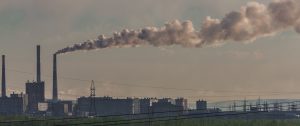
At present the difficulty of living in Norilsk is not related to prison labor, but instead is caused by extraordinary levels of pollution. In fact, the Blacksmith Institute (now PureEarth) named Norilsk to its top ten list of the worst polluted places in the world.
Essentially all of the industrial construction and subsequent industrial output was undertaken with little or no pollution controls. Partly this was due to the frequent pattern of Soviet disregard for individuals in pursuit of advancement of society as a whole. Partly this was due to the also frequent pattern of Soviet industry discounting investment that didn’t lead to additional output.
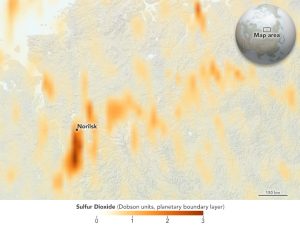
While open pit mining leads to degradation of the land, the contamination most affecting the local population is air pollution. The 24/7 expulsion of gasses, especially sulfur dioxide (SO2), from smelting centers, where the raw ore is separated by type and away from useless waste material (slag), causes Norilsk to be the world’s most polluted city, when measured by tons of air pollutants per capita. Strikingly, Norilsk’s plumes of SO2 are visible by satellite. At nearly double the SO2 output of any other anthropogenic sources, Norilsk has acted more like volcanoes. From 2005 to 2017, only the Ambrym volcano in Vanuatu released more SO2 than Norilsk did.
A combination of acid rain created from these emissions and liquid and solid waste dumping outside the city has formed a dead zone of a roughly thirty-mile radius around the city where nothing grows.
Snowfall may be black from soot or even yellow from sulfur dioxide. Though Russia has numerous locations that have air pollution problems, Norilsk alone produces 20% of Russia’s air pollution. The low volatility of the typically cold air often creates temperature inversions in the atmosphere around Norilsk, leaving the air stable and the pollution stagnant.
Numerous health woes are a consequence, especially in terms of respiratory disease. An overall measure is that life expectancy in Norilsk is ten years below the Russian average.
Perhaps things will get better in Norilsk. Mine operators have set forth a plan to reduce SO2 emission by 75% by 2023. Or maybe not. On May 29, 2020, a power plant at Norilsk accidentally leaked 20,000 tons of diesel fuel into nearby rivers. Learned of this a belated two days later, Russian President Vladimir Putin was enraged by the accident and by local authorities’ reluctance to report the spill. The diesel fuel colored the affected waterways an orange/red hue. It is possible that the oil will reach the Arctic Ocean.
On June 28th, 2020, Norilsk Nickel acknowledged that over several hours workers had pumped six thousand cubic meters of waste water into the tundra.
For a video report on the perplexities of Norilsk, go to this website:
https://www.theatlantic.com/video/index/545228/my-deadly-beautiful-city-norilsk/
Did You Know?
Check Your Understanding
Hot Off the Press
Cited and additional bibliography:
“A Manmade Volcano over Norilsk.” 2018. Earthobservatory.Nasa.Gov. June 7, 2018. https://earthobservatory.nasa.gov/images/92246/a-manmade-volcano-over-norilsk.
Agence France-Presse. 2020. “Russian Mining Giant Admits Pumping Wastewater into Arctic Tundra.” The Guardian, June 28, 2020, sec. World news. https://www.theguardian.com/world/2020/jun/29/russian-mining-giant-admits-pumping-wastewater-into-arctic-tundra.
Buder, Emily. 2017. “The Toxic City of Norilsk, Russia: ‘My Deadly Beautiful City’ – The Atlantic.” Www.Theatlantic.Com. November 8, 2017. https://www.theatlantic.com/video/index/545228/my-deadly-beautiful-city-norilsk/.
Dolgov, Anna. 2013. “Two Russian Cities on Top 10 Most Polluted Places List.” The Moscow Times. November 7, 2013. https://www.pureearth.org/BIFILES/articles/Moscow times.pdf.
Ерыгин, Евгений. 2017. Norilsk. https://tinyurl.com/norilsk-32. Attribution-ShareAlike 2.0 Generic (CC BY-SA 2.0).
Gigova, Radina. 2016. “Russian River Turned Red by Metallurgical Waste.” CNN. September 13, 2016. https://www.cnn.com/2016/09/12/world/russia-red-river-siberia/index.html.
Helque, Eric. 2004. “The City Which Should Not Exist.” Russian Life 47 (5): 38–45.
Kramer, A. E. 2017. “For One Business, Polluted Clouds Have Silvery Lining.” New York Times, July.
News.Bbc.Co.Uk. 2007. “Toxic Truth of Secretive Siberian City,” April 5, 2007. http://news.bbc.co.uk/2/hi/europe/6528853.stm.
Ninara. 2016. Norilsk. https://tinyurl.com/norilsksmoke. Attribution 2.0 Generic (CC BY 2.0).
“Norilsk Nickel Smelter.” 2007. YouTube Video. YouTube. http://www.youtube.com/watch?v=xp8_UCJTa9k&feature=related.
“Noril’sk, Northeast Siberia.” 2006. Earthobservatory.Nasa.Gov. April 30, 2006. https://earthobservatory.nasa.gov/images/6506/norilsk-northeast-siberia.
Sharapova, Olga, and Paul E. Richardson. 2007. “The City Built on Ice and Bones.” Russian Life 50 (2): 50–58.
“Siberian River Has Turned Red Before, Satellites Show.” 2016. Earthobservatory.Nasa.Gov. September 15, 2016. https://earthobservatory.nasa.gov/images/88725/siberian-river-has-turned-red-before-satellites-show.
Wiertz, Steve. 2020a. “Norilsk Area.” College of DuPage. College of DuPage GIS class. Instructor Joseph Adduci.
———. 2020b. “Northwest Russia.” College of DuPage. College of DuPage GIS class. Instructor Joseph Adduci.

